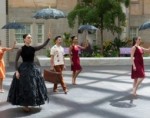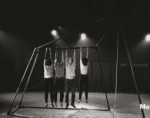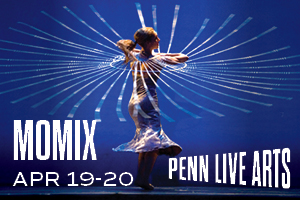
Between Two Archives
by Andrew Sargus Klein
I approached The Sentient Archive: Bodies, Performance, and Memory, edited by Bill Bissell and Linda Caruso Haviland, with the need to deepen my understanding and practice of dance criticism. A frustrating and joyful practice, it is also an act of translation, since dance is predominantly nonverbal, often abstract, and doesn’t enjoy as wide a cultural footprint as it deserves. Critical, academic, or otherwise, dance writing constitutes an archive as I generally understand it: a collection of text and media, curated by gatekeepers, and often hierarchical and exclusionary. The Sentient Archive decenters this notion by focusing on the generation of movement and the person within and through whom the movement exists. From Haviland’s introduction:
Each body stores its own particular history of living and is also a body ordered and disciplined by a history of cultural pressures within which it matures, part of a phylogenetic (or developmental) archive of the regulations and conduct and communication commanded in any particular epoch. (p. 3)
The texts in The Sentient Archive often tilt into deeper academic languages, but the heart of this anthology is lyrical and exploratory, and there is nothing ephemeral here: “No gesture is made, no matter how inventive or improvised, that does not draw in some way on a past bodily movement.” (p. 10) Or: “Given the universal and inescapable materiality of humanness, the bodied nature of thought, and the powerful appeal of both history and memory, the notion of the body as and in the archive has import for us in all aspects of our lives.” (p. 10)
The editors describe The Sentient Archive as an open-ended conversation. That’s wise, since there are absent voices and lines of inquiry that limit the anthology’s scope. Nonetheless, Bissell and Haviland have assembled an illuminating anthology for anyone creating, reviewing, researching, or thinking about dance.
In “Stalking Embodied Knowledge—Then What?” performer and ethnologist Tomie Hahn finds an irreducible heart of the conversation:
The very process of comprehending embodiment appears to dissipate the closer I get. The embodiment of knowledge presents a paradox, a perpetual loop that teases me. Although the body stands as a very real, physical entity in the world, the flow of knowledge into and from the body is not always discernible, or clear. That the body changes once it learns and embodies information continues the paradoxical loop. (p. 28)
The critic is their own paradoxical loop as well. Two loops, two archives, and between them overlapping seas of personal experience, cultural signifiers, and history. How does a writer reconcile these archives and represent them in writing? This question undoubtedly is political: between two archives lie tangible points where there may be no obvious overlap, such as race, gender, sexuality, and class. How does the performer inform their choreography with archives far outside their experience? How and where does homage denature into appropriation, influence into theft, intention into carelessness?
These questions erupt in the anthology’s first essay, wherein choreographer Alain Platel describes, with distinctly othering language, how he’s inspired by disabled people. He also notes that he developed choreography by watching video of psychiatric patients making “fierce involuntary movements.” (pg. 25)
This essay is disconcerting. It’s possible there is an issue of translation. More likely Platel isn’t part of conversations around othering and appropriation that dominate American arts dialogues. In the first section’s introduction, Haviland previews Platel’s text by writing that he “locates the performer’s body as a site that knows more than it can say, asking dancers to dig deeply into the archive of theirs or others’ bodily movements to create new and shared movement that in turn augments their own repertoires of movement action and memory” (p. 20, emphasis mine). I see “[A]sking dancers to dig deeply into the archives of others’ bodily movement” as an act of power. When Platel takes “a fierce, involuntary movement” to serve his choreography, he is plundering a marginalized group for creative profit. The patients and their archives are reduced to a footnote. Choreographic research often involves fieldwork and observation, but such research demands the same precautions as, for example, contemporary anthropology: a working understanding of power dynamics and privilege.
Platel’s essay underscores an unsettling lack of the body as a political entity throughout the anthology. With few exceptions (one quite notable), the authors do not discuss race, gender, sexuality, or class in their examinations of the body as archive. Nor do they address trauma, despite the enormous bodies of research about trauma’s physical and emotional manifestations. Given trauma’s further intersections with identity, this failure remains all the more disappointing. For The Sentient Archive, the body-as-archive is handled cautiously, leaving most radical implications largely unspoken.
Hahn’s essay includes written notation of traditional Japanese dance and observations from a monster truck rally, as well as simple exercises for mover and watcher alike. Hers concern for an ever-broadening understanding of embodied knowledge begins with dance and ends with the smallest gesture. Her text is so far removed from Patel’s that I find it hard to believe they exist in the same anthology. But they do, underlining how much ground this anthology covers.
That ground doesn’t include much scientific research, but what is present is tantalizing. “We Dance What We Remember,” by psychology professor Catherine J. Stevens, summarizes several of Stevens’ experiments that track the brain activity of dancers and non-dancers as they watch and rewatch a performance. She calls dance “a litmus test for theories of cognition that have concentrated on explaining the way humans acquire knowledge of static, verbal, or visual material” (p. 89). She draws a parallel between verbal and embodied grammars—the same biological and cultural dynamics that inform grammar can also inform how we move and how we observe movement:
If we apply this conception to dance, then dance observation, creation, and performance involve both declarative and procedural memory. There is an ongoing interplay between steps and phrases and their sequencing and structure. And as often remarked by my colleagues in dance, the art and meaning is not inherent within the steps themselves, but instead is found in the relations between the elements. (p. 92)
In “The Embodied Performance of Museum Visiting: Sacred Temples or Theaters of Memory?” that interplay extends to physical spaces. Laurajane Smith delves into intangible heritage and how people “perform” when they visit museums and cultural sites. “Performance” here extends the museum experience beyond the simple absorption of facts. Again, The Sentient Archive champions a fluid understanding of how knowledge, culture, and history are created and transformed, affirming subjective experiences—experiences that can’t ever be entirely shared—within more objective frameworks of scholarship.
This fluidity is familiar. As someone who gravitates toward modern dance, improvisational and experimental forms, and folklore, I find that this anthology offers small but remarkable reframings of how I watch and write about dance: “Dance deploys recollection and memory, along with imagination and experience, to create a series of resonances for the performer and viewer,” Jayachandran Palazhy writes in “Choreographing Somatic Memories and Spatial Residues.” “The cognitive activity of memory is critical to dance, since dance is a creation of the present, not its representation” (p. 200). At its strongest, The Sentient Archive points to bridges between viewer and performer, performer and self.
I lose the path when the anthology turns to ballet. This is a matter of personal taste, generally, but the tone of the anthology itself changes along with the subject. There are 29 essays in the anthology, but over one-fifth of the book is given to “Leap Before You Look: Honoring the Libretto in Giselle and Apollo” by Nancy Goldner and “Pavilion of Secrets” by Marcia B. Siegel. The former tracks two classic ballets in a thorough, dramaturgical form, and the latter is a short history of the Ballets Russes and an inquiry into restaging dances after the original choreography has all but vanished.
As stand-alone works, they are deep and engaging scholarship. Siegel explores “the gulf between present and disappeared productions” in order “to see how dance history invents itself” (p. 233). But as participants in the The Sentient Archive’s conversation, they read as overlong interruptions that leave little room for the organic inquiry set forth in Haviland’s introduction. In her exploration of how the character Giselle has been performed over the years, Goldner takes issue with modern dancers’ focus on Giselle’s “incorporality” (Goldner’s term). She contrasts these interpretations against older variations that hew close to the libretto and the original production of the ballet. The bodied archive in this context isn’t about the person, which is what loses me. Corporality is reduced to a narrative tool.
Valuing process above content is another angle of entry into The Sentient Archive; it helps me understand why I’m unable to approach ballet as I do other genres. It is also why Thomas F. DeFrantz’s essay, “Them: Recombinant Aesthetics on Restaging Experimental Performance,” is such an important part of the anthology. With a level and length of attention on par with Seigel and Goldner, DeFrantz dives deep into Them, choreographed by Ishmael Houston-Jones and first performed in 1985. DeFrantz examines the restaging of the work in 2010 alongside archival recordings from the 1980s. The text, in a loose, nonlinear form, jumps between film and stage, past and present, queer theory and dance history. It is a small gesture toward the anthology’s sense that expression, history, analysis, and understanding aren’t unidirectional. That the future reshapes the past and the past tilts the present. The work concerns queer men and unspoken languages such as sexual identity, cruising culture, and the existential terror of the AIDS crisis. In structured improvisation, dancers maintain a level of autonomy while working within, and breaking, certain expectations:
Improvisation forms the warp and woof of Them. The gestures of the performing bodies in motion are realized as a queer sort of body behavior, one that materializes outside of any regular motions of dance or dance theater. Because the inventory of movements—the physical lexicon of the work—becomes manifest improvisationally, in the creative exploration of the moment, the work is inherently queer in the most everyday sense, as a realization of the desire to do something unusual. (p. 272)
That autonomy also signals that the choreographer is, to a degree, decentered from the overall work. The dancers are not simply vessels for a single person’s vision—a hierarchical dynamic that can reduce a dancer to an object of transmission. Obviously, not everyone has to make their own work, but the power dynamics of the choreographer-dancer relation merit consideration. The final essay, André Lepecki’s “Choreographic Angelology,” is an important political reframing of choreography in this regard. Lepecki’s scope defies easy summation. He braids together “antihistorical physics,” “logisticality,” labor, and angelology, and somehow ends up with:
There is only this one body, preserving in insisting, to return every day. Yet one does not come back every day as a new body. One has to keep something of the past as much as one has to forget something of the past in order to perform this crucial return, this stubborn hanging on. (p. 315)
Within this text, the editors include artist statements, lyric essay-like streams of consciousness, and spare rehearsal notes, and in doing so they ensure the collection’s multiple points of entry. They push on what an “academic text” can look like, and have pushed me to reconsider what dance writing can look like. There is something deeper at work, too. Poet Cathy Lihn Che wrote, “Dance is the body’s refusal / to die.” The Sentient Archive elevates and honors that refusal. I hope to do the same in my own practice.
Bill Bissell and Linda Caruso Haviland, ed. The Sentient Archive: Bodies, Performance, and Memory. Middletown, CT: Wesleyan University Press, 2018. 360 pages.
By Andrew Sargus Klein
June 20, 2019






.png)


